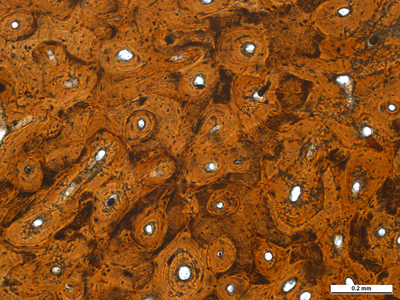Evolution of Deer: Regular Antler Cycle is Older Than Previously Thought
17.12.2020
A new study provides insight into the early evolution of the antler cycle in deer (Cervidae). The structure of the antler tissues of the oldest known fossil deer (about 12 to 18 million years old) was strikingly similar to those of deer living today. Apparently, deer had to live with periodic antler shedding from the very beginning – although the regular formation of new antlers costs the animals a lot of energy. Experts in paleohistology and ruminants led by SNSB paleontologist Gertrud Rößner have now published the results of their study in the scientific journal The Science of Nature.
Regeneration capacity: Periodically, in temperate latitudes even every year, they shed their entire antlers and form a completely new pair during the following months. This antler cycle is controlled by hormones, which in turn are under the influence of the daily amount of light irradiation, i.e. are also dependent on the geographical latitude of the habitats. An antler consists essentially of bone tissue and grows from the so-called “rosebuds” on the forehead of the deer. The regular shedding and especially the subsequent regeneration of the antlers, which in many species grow larger every year, is an energetically enormously costly process for deer, which could not really be explained according to biological principles. Therefore, scientists previously suspected a selective advantage when deer are temporarily antler-free before the next antlers for the rut must be regenerated under high energy expenditure. However, the results of the new study suggest that deer have had to live with periodic antler shedding from the beginning and that their evolutionary history has constantly been subject to the dilemma of physiological costs on the one hand and reproductive success on the other.
Ein deutsch-schweizerisches Paläontologen-Team um PD Dr. Gertrud Rößner, Kuratorin für fossile Säugetiere an der Bayerischen Staatssammlung für Paläontologie und Geologie (SNSB-BSPG), hat in einer umfassenden Vergleichsstudie die frühe Evolutionsgeschichte des Geweihzyklus bei Hirschen erforscht. Das Ergebnis ihrer Untersuchungen hat die Paläontologen überrascht: Prozesse und Mechanismen von Abwurf und Neubildung im Geweihzyklus verliefen offenbar schon bei den frühesten Hirscharten vor 18 Millionen Jahren genauso wie bei heutigen Arten.
A German-Swiss team of paleontologists led by PD Dr. Gertrud Rößner, curator of fossil mammals at the Bavarian State Collection for Paleontology and Geology (SNSB-BSPG), has conducted a comprehensive comparative study of the early evolutionary history of the antler cycle in deer. The result of their investigations has surprised the paleontologists: processes and mechanisms of shedding and new formation in the antler cycle apparently already took place in the earliest deer species 18 million years ago in exactly the same way as in today’s species.
“Our comparisons provide detailed insight into the early evolution of antler formation. The composition and structure of fossil antler tissues were strikingly similar to those of deer living today. Until now, we have assumed that the antler cycle as we know it from present-day deer evolved in a gradual evolutionary process starting from antlers that could not be shed originally and with transitional stages from exceptional to occasional shedding. But our results now show the pattern of a mechanism that has been fundamental since the evolutionary origin of deer,” explains Gertrud Rößner of the BSPG.
To better understand the origin of this cycle, the scientists analyzed the antlers of 34 fossil deer from the early and middle Miocene of Europe (about 12 to 18 million years old), many of which originate from Bavaria and are preserved and scientifically studied at the BSPG in Munich. Among the fossils were the oldest antlers known to date from the early Miocene of Procervulus praelucidus (Bavaria, Germany), Ligeromeryx praestans (Loir-et-Cher, France) and Acteocemas infans (Loiret, France). To do this, the researchers examined many details of the bone tissue, such as growth patterns, remodeling processes and dissolution phenomena, using micro-computed tomography and thin-section microscopy. Gertrud Rößner and her colleagues then compared the data obtained with antler tissues from modern deer.
Publication:
Gertrud E. Rössner, Loïc Costeur, Torsten M. Scheyer (2020) Antiquity and fundamental process-es of the antler cycle in Cervidae (Mammalia). The Science of Nature 108, 3 (2021).
Contact:
PD Dr. Gertrud Rößner
Bavarian State Collection for Paleontology and Geology (SNSB-BSPG)
Richard-Wagner-Str. 10, 80333 Munich
Tel.: 089 2180 6609
E-Mail: roessner@snsb.de
Website: bspg.palmuc.org
-

Oldest deer skull with antlers. The antlers are single forked, have no rose, and sit on a long rosebush that grew out of the skullcap just above the eyes. SNSB-BSPG 1979 XV 555 Procervulus dichotomus. (Photo: E.-M. Natzer, SNSB) -

1959II678 hare deer antlers Lagomeryx parvulus Tertiary Sandelzhausen Germany -

Fossil antler tissue consisting of several generations of rounded osteons, the building units of compact bone, with central hollow canal and layers of bone concentrically arranged around it. SNSB-BSPG 1959 II 5270 Heteroprox eggeri.(Photo: T. Scheyer, PIM UZH)